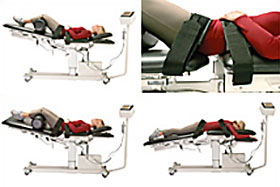Disc Injury Relief
 You’ve probably seen the newspaper ads that “hype” Spinal Decompression Therapy asking you to call some unknown doctor’s office in order to receive a free report in the mail. We do not believe anyone should have to do that!
You’ve probably seen the newspaper ads that “hype” Spinal Decompression Therapy asking you to call some unknown doctor’s office in order to receive a free report in the mail. We do not believe anyone should have to do that!
We will give you the complete facts about Spinal Decompression Therapy including clinic trials that support its effectiveness.
And we will also tell you the approximate treatment cost. We do that so you will be better able to make an informed decision about what you should do for your condition and because our fees are a fraction of what some other clinics charge.
If you need any additional information, please call our office at 508.238.8521 and ask to talk to the doctor. That’s right, I’ll talk to you personally in order to help you make the right decision.
Thanks for visiting.
Clinical Trials
 “Serial MRI of 20 patients treated with the decompression table shows in our study up to 90% reduction of subligamentous nucleus herniation in 10 of 14. Some rehydration occurs detected by T2 and proton density signal increase. Torn annulus repair is seen in all.”
“Serial MRI of 20 patients treated with the decompression table shows in our study up to 90% reduction of subligamentous nucleus herniation in 10 of 14. Some rehydration occurs detected by T2 and proton density signal increase. Torn annulus repair is seen in all.”
Eyerman, Edward MD. Simple pelvic traction gives inconsistent relief to herniated lumbar disc sufferers. Journal of Neuroimaging. Paper presented to the American Society of Neuroimaging, Orlando, Florida 2-26-98.
50+ Traction/Distraction/Decompression Article Abstracts
“Eighty-six percent of ruptured intervertebral disc (RID) patients achieved ‘good’ (50-89% improvement) to ‘excellent’ (90-100% improvement) results with decompression. Sciatica and back pain were relieved.” “Of the facet arthrosis patients, 75% obtained ‘good’ to ‘excellent’ results with decompression.
C. Norman Shealy, MD, PhD, and Vera Borgmeyer, RN, MA.
Decompression, Reduction, and Stabilization of the Lumbar Spine: A Cost-Effective Treatment for Lumbosacral Pain. American Journal of Pain Management Vol. 7 No. 2 April 1997
 “Results showed that 86% of the 219 patients who completed the therapy reported immediate resolution of symptoms, while 84% remained pain-free 90 days post-treatment. Physical examination findings showed improvement in 92% of the 219 patients, and remained intact in 89% of these patients 90 days after treatment.”
“Results showed that 86% of the 219 patients who completed the therapy reported immediate resolution of symptoms, while 84% remained pain-free 90 days post-treatment. Physical examination findings showed improvement in 92% of the 219 patients, and remained intact in 89% of these patients 90 days after treatment.”
Gionis, Thomas MD; Groteke, Eric DC. Surgical Alternatives: Spinal Decompression. Orthopedic Technology Review. 2003; 6 (5).
50+ Traction/Distraction/Decompression Article Abstracts
“All but two of the patients in the study improved at least 30% or more in the first three weeks.””Utilizing the outcome measures, this form of decompression reduces symptoms and improves activities of daily living.”
Bruce Gundersen, DC, FACO; Michael Henrie, MS II, Josh Christensen, DC. A Clinical Trial on Non-Surgical Spinal Decompression Using Vertebral Axial Distraction Delivered by a Computerized Traction Device. The Academy of Chiropractic Orthopedists, Quarterly Journal of ACO, June 2000
50+ Traction/Distraction/Decompression Article Abstracts
“Distraction results in disc rehydration, stimulated extracellular matrix gene expression, and increased numbers of protein-expressing cells.”
Guehring T, Omlor GW, Lorenz H, Engelleiter K, Richter W, Carstens C, Kroeber M. Department of Orthopaedic Surgery, University of Heidelberg, Germany. Disc distraction shows evidence of regenerative potential in degenerated intervertebral discs as evaluated by protein expression, magnetic resonance imaging, and messenger ribonucleic acid expression analysis. Spine. 2006 Jul 1;31(15):1658-65
50+ Traction/Distraction/Decompression Article Abstracts
Spinal Decompression Therapy “… allowed imbibition and complete reduction of the visualized herniation.”
“Spinal decompression therapy provided an effective means of treatment for this patient’s symptoms resulting from discal herniation (extrusion) with associated impingement of the adjacent nerve root.”
“MR imaging proved to be a useful and non-invasive technique in monitoring the efficacy of decompression therapy as it applies to this case.”
“Decompression of the spine proved to be superior to the other forms of conservative care when applied to our patient. The patients’ results were both subjectively favorable and objectively quantified.”
Treatment of an L5-S1 Extruded Disc Herniation Using a DRX-9000 Spinal Decompression Unit: A Case Report. Terry R. Yochum, DC, DACBR, Fellow, ACCR, and Chad J. Maola, D.C. Chiropractic Economics, Vol 53: Issue 2.
50+ Traction/Distraction/Decompression Article Abstracts
Contact us today to schedule your appointment.
Frequently Asked Questions
What is Spinal Decompression Therapy?
Spinal decompression therapy is a non-surgical treatment outcome for herniated or bulging discs in the neck and lower back. Anyone who has back, neck, arm or leg pain may be helped by spinal decompression therapy.
How many spinal decompression sessions will be needed and are they painful?
The number of sessions needed and your specific treatment plan will be determined by the doctor after your examination.
In almost all cases, the treatments are completely painless. In fact, some patients fall asleep during the spinal decompression session.
What type of decompression system is used and is the doctor certified in spinal decompression therapy?
After a significant amount of research, our office chose what we believe to be the most sophisticated, technologically advanced, state-of-the-art decompression system in the world.
After a significant amount of research, our office chose what we believe to be the most sophisticated, technologically advanced, state-of-the-art decompression system in the world. We also selected this decompression system due to its ability to treat discs in both the neck and the low back.
Dr. Pyne has treated disc problems for 20+ years, first with flexion-distraction and now with spinal decompression. Now that the technique has advanced to decompression, we see even severe cases doing well and going on to full pain relief, full work duties and back to participating in sports including golf and distance biking.
In regard to clinical skills, Dr. Warren Pyne has over 100 hours of post graduate training in treating disc disorder and failed back surgery with flexion-distraction and now with the new spinal decompression technique. Dr. Pyne also has completed a 3-year post-graduate neurology residency program.
What Makes Spinal Decompression Therapy so Effective?
Doctor skill combined with the table and computerized flexion-distraction head are the keys.
Proper assessment, correct positioning and the use of preprogramming patterns of distraction and relaxation may reduce disc pressure allowing necessary nutrients to enliven and accelerate disc healing.
Who can benefit from Spinal Decompression Therapy?
Anyone who has back pain or neck pain caused in whole or in part by a damaged disc may be helped by spinal decompression therapy. These conditions include herniated, protruding or bulging discs, spinal stenosis, sciatica or even prior or unsuccessful back surgery.
Are there medical studies that document the effectiveness of Spinal Decompression Therapy?
Yes! One study documented by MRI up to 90% reduction of disc herniations in 10 of 14 cases and other studies reported that the majority of ruptured disc patients achieved “good” to “excellent” results after spinal decompression therapy.
Click here if you would like to review the studies yourself or click here to read an article about spinal decompression that appeared in “To Your Health” Magazine.
Are there conditions where Spinal Decompression Therapy is not indicated?
Spinal decompression therapy is not recommended for patients who have severe osteoporosis, severe nerve damage, joint infections, neoplasm or other conditions that have compromised the bone. If you are unsure of your condition just call 508.238.8521 and ask to speak with the doctor.
Spinal surgery with instrumentation (screws, metal plates or “cages”) is also contraindicated. However, spinal decompression therapy after bone fusion or non-fusion surgery, can be performed.
Do most patients receive therapy and rehabilitative exercises in addition to Spinal Decompression Therapy?
To reduce inflammation and assist the healing process, supporting structures are treated with passive therapies (ice/heat/muscle stimulation), chiropractic adjustments (as indicated) and/or active rehabilitation in order to strengthen the spinal musculature.
How do I get started?
We want to make it easy for you to learn if you are a candidate for spinal decompression therapy. Just call our office at 50.238.8521 to arrange a consultation with one of our doctors.
Please remember to bring any MRI, CAT scans, EMG, or x-ray reports so the doctor can review them and best advise you about your treatment options.
